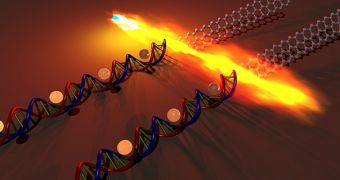Some may not believe it, but soon enough, Intel and Advanced Micro Devices won't be able to advance their silicon-based CPU technologies anymore. Sure, it will take some good years, decades even, but not as long as some may think. Normally, we'd look forward to quantum computers, based on quantum-mechanical phenomena, such as superposition and entanglement.
Quantum properties are used to represent data and perform operations in quantum systems, not transistors that encode data into binary digits (bits).
Anyway, setting the science of quantum systems aside, the point is that quantum computing won't be ready when silicon-based CPUs reach their limit of process advancement.
Thus, to fill the time gap, scientists are researching ways of improving digital computers.
And since everything eventually boils down to transistor performance, better transistors are a must. As it happens, some Stanford University scientists have come up with a method involving graphene.
As odd as it sounds, DNA was used to shape graphene into better transistors that can maintain the improvement rate of digital computers.
Graphene was demonstrated, usually theoretically, in devices running at hundreds of gigahertz already, but actually making them is another matter, especially on a grand scale.
Graphene transistors can be scaled down much further than silicon-based ones, and send signal faster on less power.
Stanford came up with a way to make graphene ribbons and, from them, graphene transistors by using DNA to provide a scaffold for the graphene synthesis.
Add to that some chemical tricks and voila! The final carbon atoms needed to make the product are in place and ready to work.
It's all thanks to the DNA’s simple four-base binding and organizational system, which the scientists used to quickly and accurately create their basic graphene template. A platter of silicon was dunked into a DNA strand-rich solution, then “combed” with molecular tools and stretched, becoming straight and uniform.
From there, they heated and exposed copper-treated DNA to hydrocarbon methane, making them donate some of the carbon atoms to create a pure-carbon honeycomb structure. Small bunched regions that defy graphene’s uniform perfection still exist though, making the process still imperfect.
Nevertheless, actual graphene transistors could be created with the “graphitic” ribbons. Just in time too, since Moore's Law will reach its end around the end of the decade.

 14 DAY TRIAL //
14 DAY TRIAL //